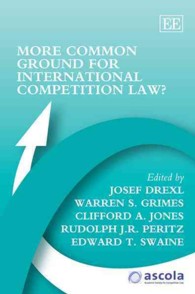- ホーム
- > 洋書
- > 英文書
- > History / World
Full Description
The long awaited conclusion to the magisterial Money and Banking in Medieval and Renaissance Venice.
Originally published in 1997. In 1985 Frederic C. Lane and Reinhold C. Mueller published the magisterial Money and Banking in Medieval and Renaissance Venice, volume 1: Coins and Moneys of Account. Now, after ten years of further research and writing, Reinhold Mueller completes the work that he and the late Frederic Lane began. The history of money and banking in Venice is crucial to an understanding of European economic history. Because of its strategic location between East and West, Venice rapidly rose to a position of preeminence in Mediterranean trade. To keep trade moving from London to Constantinople and beyond, Venetian merchants and bankers created specialized financial institutions to serve private entrepreneurs and public administrators: deposit banks, foreign exchange banks, a grain office, and a bureau of the public debt. This new book clarifies Venice's pivotal role in Italian and international banking and finance. It also sets banking—and panics—in the context of more generalized and recurrent crises involving territorial wars, competition for markets, and debates over interest rates and the question of usury.
Contents
List of Illustrations
List of Tables
Preface
List of Abbreviations
Part I. Local Banks and Bankers: The Institutional Side
Chapter 1. From Moneychanging to Deposit Banking
Chapter 2. The Supervision and Regulation of Banking
Chapter 3. The Organization and Operation of Banking Enterprises
Part II. The Vagaries of Deposit Banking: A History Seen Through Panics, Bankruptcies, and Liquidations
Chapter 4. Bank Failures in the Trecento
Chapter 5. Bank Failures in the Quattrocento
Chapter 6. The Making of the Panic of 1499-1500
Part III. The Money Market and Foreign Exchange
Chapter 7. Florentine Merchant Bankers and Their Community
Chapter 8. Exchange and the Money Market
Part IV. Public Debt and Private Wealth: The Floating Debt
Chapter 9. The Grain Office: A "Swiss Bank" for the Nest Eggs ofTerraferma Lords, a Quasi-Public Bank for Venetians
Chapter 10. Bank Loans to the State in the Fifteenth Century
Part V. Public Debt and Private Wealth: Forced Loans and Marketable Credits
Chapter 11. Venice's Monte Vecchio: An Overview
Chapter 12. Criteria Employed in Assessing Patrimonies
Chapter 13. Family and Finance: Forced Loans and the Open Market at Work
Conclusion
Appendixes
Bibliography
Index







